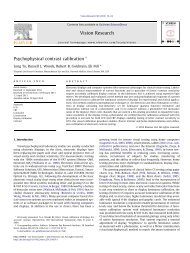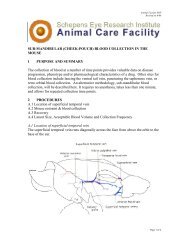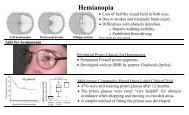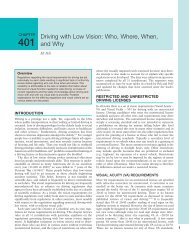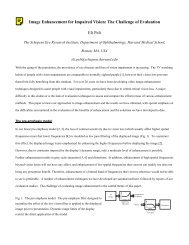In-the-Spectacle-Lens Telescopic Device for Low Vision
In-the-Spectacle-Lens Telescopic Device for Low Vision
In-the-Spectacle-Lens Telescopic Device for Low Vision
Create successful ePaper yourself
Turn your PDF publications into a flip-book with our unique Google optimized e-Paper software.
The afocal condition is achieved when <strong>the</strong> distance between objective and ocular lenses,called tube length L, is equal to <strong>the</strong> difference of <strong>the</strong> focal lengths of both lenses. <strong>In</strong> thisembedded design, light travels through <strong>the</strong> carrier lens of refractive index n. Under <strong>the</strong> thin-lensapproximation, it is generally derived as:obocoboc( − M ) f ocL = f ′ − f = −nf+ nf ′ = n 1 ′ . (2)Attending to <strong>the</strong> sign of focal lengths in <strong>the</strong> case of <strong>the</strong> Galilean telescope, it results as:( M − ) focL = n 1 ′ . (3)The second most important parameter <strong>for</strong> a bioptic telescope is <strong>the</strong> field-of-view (FOV).Ei<strong>the</strong>r <strong>the</strong> objective or <strong>the</strong> ocular may serve as <strong>the</strong> limiting aperture in a Galilean telescope. TheFOV, on <strong>the</strong> retina of <strong>the</strong> wearer, is determined by ei<strong>the</strong>r <strong>the</strong> angle spanned at <strong>the</strong> pupil by <strong>the</strong>ocular lens or <strong>the</strong> angle spanned by <strong>the</strong> image of <strong>the</strong> objective as seen through <strong>the</strong> ocular; <strong>the</strong>smaller of <strong>the</strong>se two angles is <strong>the</strong> FOV. <strong>In</strong> <strong>the</strong> design of <strong>the</strong> Galilean telescope shown in Fig. 3a,<strong>the</strong> carrier lens thickness limits <strong>the</strong> periscopic mirrors’ width but not <strong>the</strong>ir height. Since wewould like to keep <strong>the</strong> carrier lens as thin as practical <strong>for</strong> cosmetic and weight considerations,<strong>the</strong> field of such a telescope is likely to be taller than it is wide (Fig. 3b). This is less thanoptimal as <strong>the</strong> width of <strong>the</strong> FOV is considered more important <strong>for</strong> bioptics than <strong>the</strong> height. <strong>In</strong>addition, <strong>the</strong> exit pupil, <strong>the</strong> image of <strong>the</strong> objective <strong>for</strong>med by <strong>the</strong> ocular, is smaller than <strong>the</strong>objective itself, since <strong>the</strong> lateral magnification is 1/M.The second factor affecting <strong>the</strong> FOV is <strong>the</strong> distance between <strong>the</strong> field-limiting apertureand <strong>the</strong> eye’s pupil. Since <strong>the</strong> device is meant to be embedded in a spectacle lens, <strong>the</strong> distancefrom <strong>the</strong> last optical surface to <strong>the</strong> eye should be as similar as possible to that of conventionalspectacle ophthalmic lenses. This vertex distance is usually 12 to 14mm 37 . <strong>In</strong> <strong>the</strong> case of <strong>the</strong>Galilean design <strong>the</strong> exit pupil of <strong>the</strong> telescope lies within <strong>the</strong> telescope. Generally, <strong>the</strong> exit pupilacts as a field-limiting aperture and, since <strong>the</strong> eye can never be placed in <strong>the</strong> same plane, it limits9




